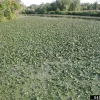X
CONTACT US
Great Lakes Center, SAMC 319
SUNY Buffalo State
1300 Elmwood Ave., Buffalo, NY 14222
wnyprism@buffalostate.edu
(716) 878.4708
SUBSCRIBE TO LISTSERV
FOLLOW US
CONTACT
Water Chestnut
COMMON NAME:
Water chestnutSCIENTIFIC NAME:
Trapa natansORIGIN:
Europe and AsiaDESCRIPTION:
Water chestnut is a fast-growing, floating annual that can grow to 16 ft. It has feathery, submersed leaves and triangular, toothed, floating leaves that are glossy. Floating leaf stalks have visible bulbous bladders and commonly form rosettes. Flowers with four white petals normally bloom in July. The most distinctive trait of this plant is its thorny nutlets which mature in late summer. Reproduction occurs from these very sharp nutlets and from fragmentation of the rosettes.HABITAT:
Water chestnut is found in slow-moving and/or still, high-nutrient waters with soft substrate and neutral to alkaline pH.THREAT:
Impenetrable mats of water chestnut can cover large expanses of water, altering water quality and clarity, eliminating the growth of native aquatic plants, and making boating, fishing and swimming hazardous.MANAGEMENT:
Small populations can be controlled by hand pulling. Large infestations have been controlled in the northeast by the use of mechanical harvesters and the application of aquatic herbicides. Bio-controls are currently being researched.
WNY PRISM PRIORITY:
Tier 3 - Containment
ADDITIONAL RESOURCES:
Water chestnut is a prohibited species in New York State - for more information on Prohibited and Regulated Species, visit http://www.dec.ny.gov/animals/99141.html.
NYS Prohibited and Regulated Species - Part 575:
PATHWAYS OF INVASION:
Water chestnut was introduced to North America as an ornamental water garden plant. Water chestnut can propagate from broken off plant pieces and is spread when those plant pieces attach to boats, trailers and other aquatic gear.
REGIONAL DISTRIBUTION:
Locally Common







